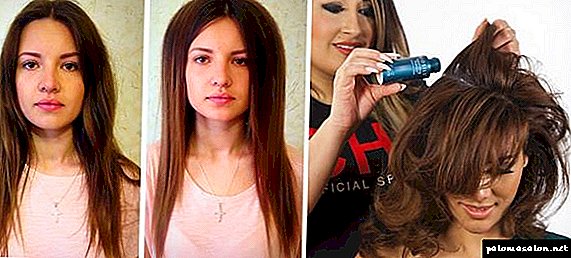Alopecia occurs in people of any age. Most often, the causes of total alopecia lie in adverse environmental conditions, stress, and genetic predisposition. There are different types of this disease. Special attention deserves total alopecia, in which hair is intensely lost.
 Alopecia has many causes
Alopecia has many causes
What are the types of alopecia in women and men?
Hair loss depends on many factors. Many causes of alopecia have not been studied until now. In some cases, baldness occurs under the influence of several reasons.
 Alopecia affects both men and women.
Alopecia affects both men and women.
The following types of disease are distinguished:
- cicatricial alopecia occurs as a result of damage to the hair follicles. Burns, infectious fungal diseases or inflammatory processes lead to baldness,
- non-cicatrix form appears without damage to the skin, and baldness can overgrow with time. At the same time there is a splash.
 Plesch
Plesch
Bald non-crown character are divided into the following types:
- Nesting or focal baldness is characterized by the appearance of round-shaped baldness.
 Bald spots
Bald spots
 Total scar alopecia cannot be cured
Total scar alopecia cannot be cured
Total scar alopecia is not amenable to recovery. You can restore strands using transplant hair follicles. Many diseases cause folliculitis - an inflammatory process in the bulbs and their damage.
Androgenic alopecia is common among men. Often influenced by hereditary predisposition.
A focal variety may be the result of a serious infection, injury or surgery.
 Diffuse look - most common among women
Diffuse look - most common among women
Diffuse appearance is more common in women. Hair loss occurs as a result of pregnancy, stressful conditions or extreme situations.
Total baldness - what is it?
Total alopecia is one of the most severe forms of focal alopecia. It begins rapidly - lost whole strands of hair. This form of illness occurs when chemicals are affected. After removing the cause of baldness, hair begins to grow.
 Total alopecia is one of the most severe forms of alopecia.
Total alopecia is one of the most severe forms of alopecia.
What causes hair loss in adults and children?
Often the balding area extends to the entire surface of the head. This form of deprivation of hair is called total. Total alopecia in women and men is characterized by loss of hair on the head, as well as on the face for one or two months.
 Total alopecia can deprive hair for a month or two
Total alopecia can deprive hair for a month or two
In this case, the changes affect the nails A bumpy surface and longitudinal grooves appear.
The following reasons for the occurrence of this disease are highlighted:
- Disorders of the hormonal system, which occur during pregnancy or in diseases of the thyroid gland or ovaries.
- Diseases of the immune system.
- The influence of genetic predisposition.
- Underdevelopment of follicles from birth.
- Stressful situations and neuropsychiatric disorders that cause violations of the microcirculation of blood and the normal functioning of arterial and venous blood.
 Hair loss is a stressful situation in itself.
Hair loss is a stressful situation in itself.
Signs of disease
The first symptoms of baldness are rapidly thinning hair. In women with long strands, spit thickness decreases. At the same time a lot of hair remains on the comb. Total alopecia in men is manifested by transmission of the scalp in certain places, and then the fluff remains.
 Quickly thinning hair - the first sign of balding
Quickly thinning hair - the first sign of balding
In children, hair loss occurs for the same reasons as in adults. In childhood, this phenomenon harms self-esteem. Therefore, you need as soon as possible to show the child to the doctor.
The main symptom of alopecia is hair loss on the head and face: eyelashes, beard, eyebrows. Also changes the structure of the nails. With this ailment, recovery is particularly difficult. The process takes several years. In the worst case, hair may not appear on the head.
Disease treatment
In most cases, treatment of total alopecia has a positive result. At the same time, the follicle cells do not disappear and can be restored during treatment. The treatment is prescribed by a special doctor. Before therapy, you will have to undergo a full examination and test.
- Blood tests for the presence of antibodies and hormones.
- Specific ultrasounds.
- Biopsy of the skin of the head.
Means can be herbal or medicinal origin. Also used methods of physiotherapy and beauty treatments.
 Treatment of alopecia should be complex
Treatment of alopecia should be complex
The main method of treatment includes the elimination of the cause of hair loss. The following actions can be performed:
- Treatment of the underlying disease.
- Correction of hormonal background.
- The use of missing trace elements.
- Nutrition correction.
- In case of unfavorable environmental conditions, a change of residence is required.
- The abolition of drugs that have caused baldness.
Vitamins, immunomodulators and hormonal preparations are used to restore hair growth.
 After treatment, hair regrow again
After treatment, hair regrow again
In case of hair loss in children, you should also contact a psychotherapist.
A set of measures to eliminate alopecia: reviews from medical forums confirm the information
Treatment is performed using the following methods:
- Immunomodulatory drugs (Anthralin) and glucocorticosteroids are used to increase immunity.
- Effects on the nervous system are made with plant-based depressants and antidepressants.
- Used minoxidil and alternative drugs. Used vasodilator ointment.
- In androgenic alopecia, dehydrosterone blockers are used.
- Photosensitizers are used.
- Jojoba and avocado oils that contain polyunsaturated acids are used.
To improve the digestibility of microelements, the organs of the digestive system are treated. Is the correction of the diet. Protein food is introduced, which is rich in selenium, iron and zinc.
 A healthy lifestyle reduces the risk of baldness.
A healthy lifestyle reduces the risk of baldness.
For treatment, physiotherapeutic methods are used, which include mesotherapy, microcurrent therapy and iontophoresis. Vacuum and manual massage is recommended.
Restorative therapy includes taking vitamins, methionine and pantothenic acid.
In difficult cases, hair transplantation is used. In this case, the follicles are moved from the back of the head to the areas of baldness. If you suspect a total alopecia, do not delay the visit to the doctor. With timely treatment, the chances of hair restoration increase.
Alopecia in women: causes, types, symptoms
Loss is a normal physiological process. Every day a person loses approximately 50-150 hairs. In place of fallen new ones soon appear. Therefore, if the amount of lost hair does not exceed the norm, you should not worry.
Sometimes, as the reviews show, there may be periods of increased precipitation. It is celebrated after shampooing, dying hair, creating complex, intricate hairstyles. Such phenomena quickly pass, so it’s too early to talk about the problem of baldness. If you suspect the development of alopecia, conduct a simple test consisting of three steps.
- Weave braids. In the morning, without combing the strands, braid a tight braid and fix it. In this form, leave your hair for a day.
- Inspection combs. The next morning, carefully unscrew the braid and comb the curls. Carefully inspect the comb and count the number of hair remaining on it.
- Analysis of the problem. If you met the above rules, then there is no reason to panic. Otherwise, it's time to think about visiting a doctor.
12 factors that worsen the condition of the hair
Causes of baldness in women are quite diverse. Sometimes the source of the problem is improper care. But more often the causes are more serious, they require long treatment. In order to correctly diagnose the source of alopecia and select an adequate therapy, it is necessary to contact a trichologist. Hair loss can trigger 12 factors.
- Hormonal adjustment. A significant loss of strands occurs in young girls during puberty. Pregnant women suffer from hair loss. Moreover, baldness can continue after childbirth, until such time as hormonal levels are restored. Women also complain about the massive loss of hair during menopause.
- Chronic disease. Diseases (rheumatoid arthritis, lupus erythematosus), intoxication, infectious diseases (pneumonia, tuberculosis) and gynecological pathologies (polycystic ovary) can be the cause of intense hair loss. Such diseases are accompanied not only by loss of hair, but also by whole complexes of symptoms, which are dangerous for health to ignore.
- Endocrine disorders. Any diseases affecting the thyroid gland, ovaries, adrenal glands, provoke a pathological change in hormonal balance. Against the background of these ailments many visual disturbances develop. The skin becomes pale, vegetation may appear on the face, body. Sometimes the voice becomes rough, thinning begins. Hypothyroidism, a condition in which the thyroid does not produce the required amount of hormones, becomes a frequent cause of alopecia.
- Improper nutrition. Unbalanced diet, adherence to strict diets, improper vegetarianism lead to a deficiency of trace elements and vitamins. The body loses strength, avitaminosis, anemia develops. Such pathologies lead to hair loss.
- Drug abuse. Drugs can adversely affect the condition of the strands. Long-term therapy with antidepressants, hormonal drugs, and laxatives leads to their weakening and loss. Antineoplastic drugs, in particular chemotherapy, also provoke the development of alopecia.
- Excessive stress. Psychological shocks, nervous diseases and constant stress provoke vasoconstriction. As a result, the nutrition of the hair follicles deteriorates significantly. Hair that does not receive the necessary nutrients is weakened, thinned and falls out.
- Fungal pathology. A fungal infection can provoke the appearance of bald spots - rounded bald spots on the head. Pathogenic microorganisms damage follicles. Mycelium completely deprives strands of nutrients, causing them to die.
- Traumatic hairstyles. African pigtails, tight tails, complicated hairstyles have a very negative impact on the condition of the hair. Excessive straining leads to impaired microcirculation. Disrupted nutrition of follicles.
- Aggressive procedures. To worsen the condition of the locks can: frequent staining, discoloration, chemical curls. The abuse of hot hair dryer and tongs also leads to a significant thinning of hair.
- Genetic predisposition. Some types of alopecia can be inherited. If there have been cases of female baldness in the family, then there is a chance that you can “get” inherited alopecia.
- Exposure to cold. From alopecia often suffer those women who do not like to wear hats in the cold. Cold spasms of blood vessels. Nutrition of bulbs worsens, there is a massive rejection of hair.
- Caffeine abuse. Lovers of drinking a day more than three cups of coffee can face baldness. Caffeine causes vasospasm leading to severe thinning.
3 forms of the disease with a description of symptoms
Analyzing the causes of hair loss and the characteristic symptoms of alopecia in women, trichologists identified several types of baldness. Each of them needs its own treatment. Therefore, initially you need to determine which form you are facing. Detailed information is presented in the table below.
Table - The main types of alopecia, causes and manifestations
Total baldness - what is it?
Total alopecia is one of the most severe forms of focal alopecia. It begins rapidly - lost whole strands of hair. This form of illness occurs when chemicals are affected. After removing the cause of baldness, hair begins to grow.




